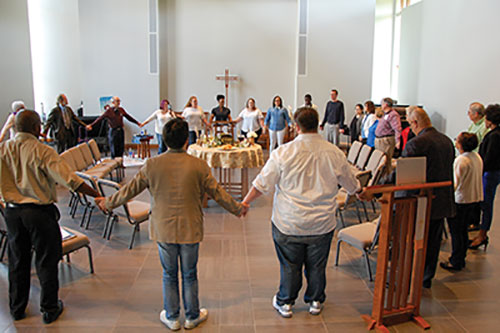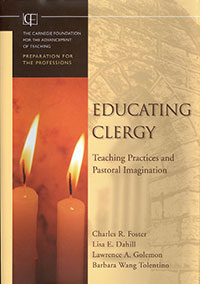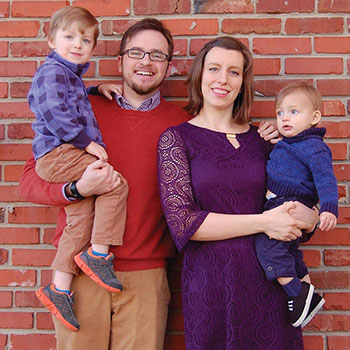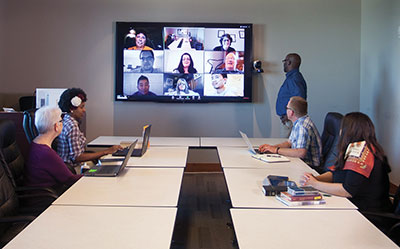 |
| In May, student Kimberly White (at far side of circle, in blue shirt and white pants) led her "senior chapel" service at Central Baptist Theological Seminary. |
After Robert Johnson became academic dean at Central Baptist Theological Seminary in 2009, he decided to visit a different church each Sunday for a year. In his words, he wanted to “learn what’s going on, what it’s like, and what’s happening out there.”
These visits and other experiences led Johnson to conclude that the seminary’s traditional curriculum was not teaching students what they needed to know in a rapidly changing culture. Economic distress was widespread. Church attendance was down. Values were changing, technology was changing, demographics were changing, and even the definition of “family” was changing.
With support from President Molly T. Marshall, Johnson initiated some sweeping changes. During the past five years, the seminary has completely transformed its M.Div. curriculum — both the course content and the delivery systems. Most courses are now delivered simultaneously in campus classrooms and to students elsewhere through videoconferencing. Students at nine extension centers throughout the United States take the same courses at the same time as on-campus students in traditional classrooms, and students not at extension sites can take the same courses in their own homes or offices (if permitted by their respective state laws).
The changes have helped propel Central into the ranks of the fastest growing seminaries in North America, according to a 2015 report by the Association of Theological Schools. The seminary’s enrollment increased from 103 (in the 2009–10 academic year) to 287 (in 2014–15).
Central Baptist Theological Seminary is affiliated with the American Baptist Churches U.S.A. and has a strong relationship with the Cooperative Baptist Fellowship. Before initiating its curricular changes, the seminary had already sold its old campus in Kansas City, Kansas, and moved to a smaller site in nearby Shawnee. This freed up some resources to experiment with the curriculum.
The content of the curriculum
“Our starting point was to find the best research to help us look at our curriculum. I came across the book Educating Clergy: Teaching Practices and Pastoral Imagination,” says Johnson. The curriculum revision process began in 2009 with a systematic study of the book, which was based on research by a group of theological educators with funding from the Carnegie Foundation for the Advancement of Teaching. The book proposed a theological education curriculum based on four foundations or “pillars” — pedagogies of interpretation, of formation, of contextualization, and of performance. Johnson asked all faculty members to read the book and assigned each one a chapter to study.
 |
|
A review of Educating Clergy: Teaching Practices and Pastoral magination appeared in the Autumn 2006 issue of In Trust. Find it here.
|
David May, professor of New Testament and director of online curriculum design, says that the faculty initially discussed the book as a committee of the whole, but afterwards, they moved into small groups in order to create goals and projected outcomes for each course. “It was a very good experience,” he says, “and that book was a helpful launching pad for us.”
As a result of that process, the faculty developed an experimental curriculum they called Create, organized around the book’s four pillars. Courses in interpretation included Hebrew Bible, New Testament, and biblical interpretation. Formation courses included Christian ethics, theological foundations, and caring ministries. Contextualization courses included leadership and innovation, missional imagination, ministry in a pluralistic world, and Christian heritage. Performance courses included the art of worship leadership, homiletics, media for ministry development, and creativity in public ministries.
Central added a fifth pillar — contextual learning — which is organized around three required internships and a capstone project. The goal for each internship is to acquire applied ministry skills in a different social setting or context.
During the 2009–10 academic year, the seminary initiated the Create curriculum to a select group of a dozen entering students, who were persuaded to participate in the new curriculum with the incentive of scholarship assistance. “We let the students who were admitted to this program know that this was an experimental approach to education,” says Johnson. “The Create curriculum was adapted to what we thought ministry was becoming. It was more entrepreneurial in its focus than the traditional academic curriculum.”
This pilot group took the new courses, while all other students were enrolled in the traditional curriculum. With each entering cohort of students, faculty evaluated the program and looked for improvements to make for the next entering cohort. The seminary offered dual-track M.Div. programs for five years.
Among the nine initial students was Tyler Tankersley, who later directed the Create program and is now pastor of a Baptist church in Missouri. “One of the things I liked about it was that it went outside the traditional model,” he says. “We had training not only in theology, biblical studies, and homiletics, but also in entrepreneurship, sustainability, and fundraising.”
Tankersley says that his courses focused on entrepreneurship — how to use his talents to meet needs that were not being met by existing institutions. “For decades, people have been trained for a job market where they’re going to fill a hole that someone has,” he says. “Instead, they were trying to encourage us to be creative and use our own gifts to create new expressions of ministry that maybe nobody has thought of.”
 |
| Tyler Tankersley (shown here with his wife, Jessica Tankersley, and their children) was one of the first students in the Create program and was later a member of the seminary staff. He recently left to become pastor of the First Baptist Church of Cape Girardeau, Missouri. |
One example of entrepreneurship: Tankersley says the sustainability course focused on answering the question, “How can we create ministries that are somewhat self-funded and not reliant on the traditional model of just continually receiving donations?”
The 2015–16 academic year is the first year that the new curriculum has been fully implemented for all students. “It’s been a long, long process and a lot of hard work,” says May, the director of online curriculum design. “We met two times a week for two years working on the curriculum. We’re still in the process of rolling it out.”
May says they experimented with different schedules to determine what worked best with most students. The seminary also converted from a semester system to a trimester system. “We developed this out of our research on how adult learners prefer to do education,” says Johnson. “They really prefer a sustained education with periodic breaks. We have three 12-week terms with a one-month break during the Advent season,” he says.
The transformation of curriculum delivery
The new curriculum combines traditional classes and distance learning into hybrid courses. Any particular class may have students in a classroom listening to a professor giving lectures and off-campus students participating in the class by the use of videoconferencing technology.
“We talk about whether students are ‘local’ or ‘remote,’” says Johnson. “It doesn’t matter where the students live. We have at least 15 or 20 states represented in our student body.”
Johnson adds that Central has Korean language sites in Seattle, Los Angeles, Dallas, Austin, Houston, and St. Louis. “One of our values has been to become more diverse in our educational programs, faculty, and outlook. We have received appeals to start more of these teaching sites than we are able to accept,” he says.
The seminary is authorized by the National Council for State Authorization Reciprocity Agreements (NC-SARA) to offer distance courses in 34 states. SARA is a voluntary agreement among member states that establishes comparable standards for distance-education courses and programs. It enables the seminary to avoid the cumbersome process of getting course approvals from each individual state.
The seminary uses the Zoom conferencing software, which allows synchronous interaction of professors and students on laptops or smartphones. May describes the software as “very intuitive and not difficult to use.”
Terrell Carter, assistant professor of practical theology and director of the contextual learning curriculum, says that in the last class he taught, he had five on-campus students and multiple students in other cities. “If students needed to take out-of-town trips, they were still able to log into the course and do everything they needed to participate in the class,” he says. “They can share screens and share documents. All the classes were recorded, so students can go back and review a particular class or portion of the class.”
 |
| This past spring semester, Dr. Terrell Carter (standing, in blue shirt) taught Foundations for Seminary Studies to a class that included both on-campus students and distance learners who took part via teleconference. |
As part of the contextual learning curriculum, Carter says that students work on a capstone project in an area that is important to them. They research that area and present their project to a group of faculty members. For example, one of his students developed a curriculum for African-American churches called “From Shacking Up to the Altar: Creating a Pre-Marriage Counseling Program for African-American Couples.” The curriculum was designed to help couples to transition from living together and having children out of wedlock to getting married. Carter says that his student designed a curriculum that was relevant to his community, and then he started counseling multiple couples.
“Technology offers a new option for students who may not have been able to complete a degree because they couldn’t afford to travel,” Carter says. One of those students is Joshua Payne, a first-year student in the M.Div. program. He participates in most classroom activities from 80 miles away in Concordia, Missouri, where he is a farmer on a 600-acre family farm. “I have taken online courses, and I don’t like them all that much because they’re too intellectual and not focused on people,” he says.
But Central’s classes fit his needs. Some are broken up into one or two weeks of on-campus meetings followed by remote online classes, which allow synchronous video interaction between the professor and students. One of his classes met on campus for just the first and last weeks of the trimester. “I like getting to know and talk and see people face to face,” says Payne. “It helped me to feel personally invested. I heard other students talk about their dreams and aspirations. I was able to invest more in other students rather than just a nameless face,” he says.
He adds that in one class, “We got together with students from Myanmar, Georgia, and New York. It was basically a continual conversation. The teacher did a good job of not just providing information, but facilitating topics that we talked about.” He says some seminaries try to shape their students into a “pastor” mold, but he feels that the program at Central is helping him discover his unique ministry. “They are interested in what I am interested in. I am a farmer, and I tell people I am going to seminary so I can be a farmer, not so I can be a pastor.”
“I have realized that economic, chemical, biological paradigms of farming eventually end up failing,” he says. “The only framework which reconciles both care of the land and care of the soul is Christian theology. Central has encouraged me to consider topics from multiple theological perspectives instead of spoon-feeding me one perspective and forcing me to regurgitate answers. In my experience with farming, willingness to explore is the most important mental characteristic of a farmer.”
Molly T. Marshall, now in her 11th year as president, has overseen the student-body growth of 179 percent during the past five years. “We have been strategic by experimenting within the already approved program offerings,” she told the Association of Theological Schools in an article available here. She cited the Create curriculum, which has added 12 new M.Div. students each year for six years, and a women’s leadership initiative that is following the same model. Students learn entrepreneurial skills and financial literacy, preparing them for a capstone project in which they launch a startup ministry. Marshall also attributes Central’s success to its nine off-campus sites with integrated online learning and an active social media program.
“We were very attentive to multicultural issues and saw immigrant populations as a sector that was not being sufficiently served,” she says. “We have learned that it is absolutely critical to try to offer relevant and contextual theological education to support the school’s mission and values,” she adds.
David E. Sumner is professor emeritus of journalism at Ball State University in Muncie, Indiana. He is a graduate of the School of Theology of the University of the South.